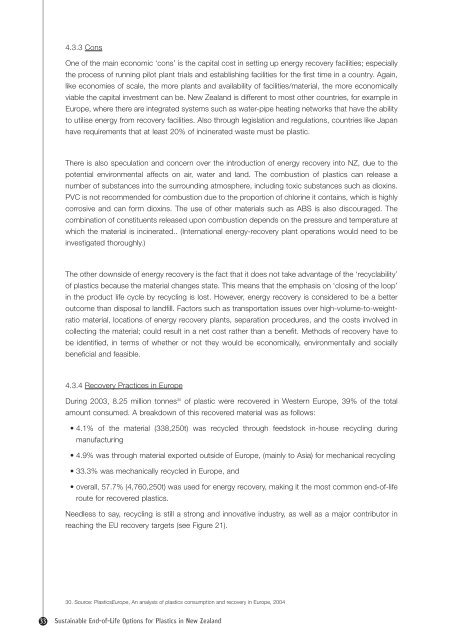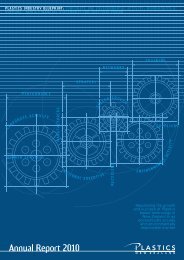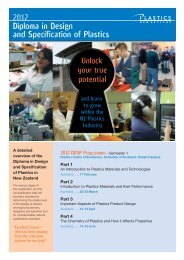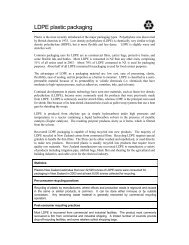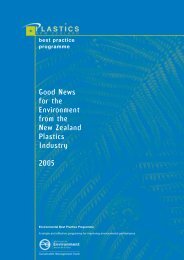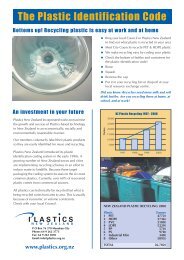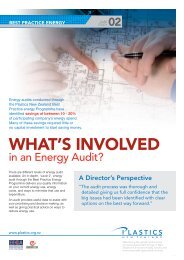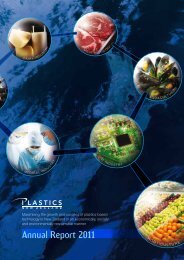Sustainable End-of-Life Options for Plastics in New Zealand
Sustainable End-of-Life Options for Plastics in New Zealand
Sustainable End-of-Life Options for Plastics in New Zealand
You also want an ePaper? Increase the reach of your titles
YUMPU automatically turns print PDFs into web optimized ePapers that Google loves.
4.3.3 Cons<br />
One <strong>of</strong> the ma<strong>in</strong> economic ‘cons’ is the capital cost <strong>in</strong> sett<strong>in</strong>g up energy recovery facilities; especially<br />
the process <strong>of</strong> runn<strong>in</strong>g pilot plant trials and establish<strong>in</strong>g facilities <strong>for</strong> the first time <strong>in</strong> a country. Aga<strong>in</strong>,<br />
like economies <strong>of</strong> scale, the more plants and availability <strong>of</strong> facilities/material, the more economically<br />
viable the capital <strong>in</strong>vestment can be. <strong>New</strong> <strong>Zealand</strong> is different to most other countries, <strong>for</strong> example <strong>in</strong><br />
Europe, where there are <strong>in</strong>tegrated systems such as water-pipe heat<strong>in</strong>g networks that have the ability<br />
to utilise energy from recovery facilities. Also through legislation and regulations, countries like Japan<br />
have requirements that at least 20% <strong>of</strong> <strong>in</strong>c<strong>in</strong>erated waste must be plastic.<br />
There is also speculation and concern over the <strong>in</strong>troduction <strong>of</strong> energy recovery <strong>in</strong>to NZ, due to the<br />
potential environmental affects on air, water and land. The combustion <strong>of</strong> plastics can release a<br />
number <strong>of</strong> substances <strong>in</strong>to the surround<strong>in</strong>g atmosphere, <strong>in</strong>clud<strong>in</strong>g toxic substances such as diox<strong>in</strong>s.<br />
PVC is not recommended <strong>for</strong> combustion due to the proportion <strong>of</strong> chlor<strong>in</strong>e it conta<strong>in</strong>s, which is highly<br />
corrosive and can <strong>for</strong>m diox<strong>in</strong>s. The use <strong>of</strong> other materials such as ABS is also discouraged. The<br />
comb<strong>in</strong>ation <strong>of</strong> constituents released upon combustion depends on the pressure and temperature at<br />
which the material is <strong>in</strong>c<strong>in</strong>erated.. (International energy-recovery plant operations would need to be<br />
<strong>in</strong>vestigated thoroughly.)<br />
The other downside <strong>of</strong> energy recovery is the fact that it does not take advantage <strong>of</strong> the ‘recyclability’<br />
<strong>of</strong> plastics because the material changes state. This means that the emphasis on ‘clos<strong>in</strong>g <strong>of</strong> the loop’<br />
<strong>in</strong> the product life cycle by recycl<strong>in</strong>g is lost. However, energy recovery is considered to be a better<br />
outcome than disposal to landfill. Factors such as transportation issues over high-volume-to-weightratio<br />
material, locations <strong>of</strong> energy recovery plants, separation procedures, and the costs <strong>in</strong>volved <strong>in</strong><br />
collect<strong>in</strong>g the material; could result <strong>in</strong> a net cost rather than a benefit. Methods <strong>of</strong> recovery have to<br />
be identified, <strong>in</strong> terms <strong>of</strong> whether or not they would be economically, environmentally and socially<br />
beneficial and feasible.<br />
4.3.4 Recovery Practices <strong>in</strong> Europe<br />
Dur<strong>in</strong>g 2003, 8.25 million tonnes 30 <strong>of</strong> plastic were recovered <strong>in</strong> Western Europe, 39% <strong>of</strong> the total<br />
amount consumed. A breakdown <strong>of</strong> this recovered material was as follows:<br />
• 4.1% <strong>of</strong> the material (338,250t) was recycled through feedstock <strong>in</strong>-house recycl<strong>in</strong>g dur<strong>in</strong>g<br />
manufactur<strong>in</strong>g<br />
• 4.9% was through material exported outside <strong>of</strong> Europe, (ma<strong>in</strong>ly to Asia) <strong>for</strong> mechanical recycl<strong>in</strong>g<br />
• 33.3% was mechanically recycled <strong>in</strong> Europe, and<br />
• overall, 57.7% (4,760,250t) was used <strong>for</strong> energy recovery, mak<strong>in</strong>g it the most common end-<strong>of</strong>-life<br />
route <strong>for</strong> recovered plastics.<br />
Needless to say, recycl<strong>in</strong>g is still a strong and <strong>in</strong>novative <strong>in</strong>dustry, as well as a major contributor <strong>in</strong><br />
reach<strong>in</strong>g the EU recovery targets (see Figure 21).<br />
30. Source: <strong>Plastics</strong>Europe, An analysis <strong>of</strong> plastics consumption and recovery <strong>in</strong> Europe, 2004<br />
33 <strong>Susta<strong>in</strong>able</strong> <strong>End</strong>-<strong>of</strong>-<strong>Life</strong> <strong>Options</strong> <strong>for</strong> <strong>Plastics</strong> <strong>in</strong> <strong>New</strong> <strong>Zealand</strong>


